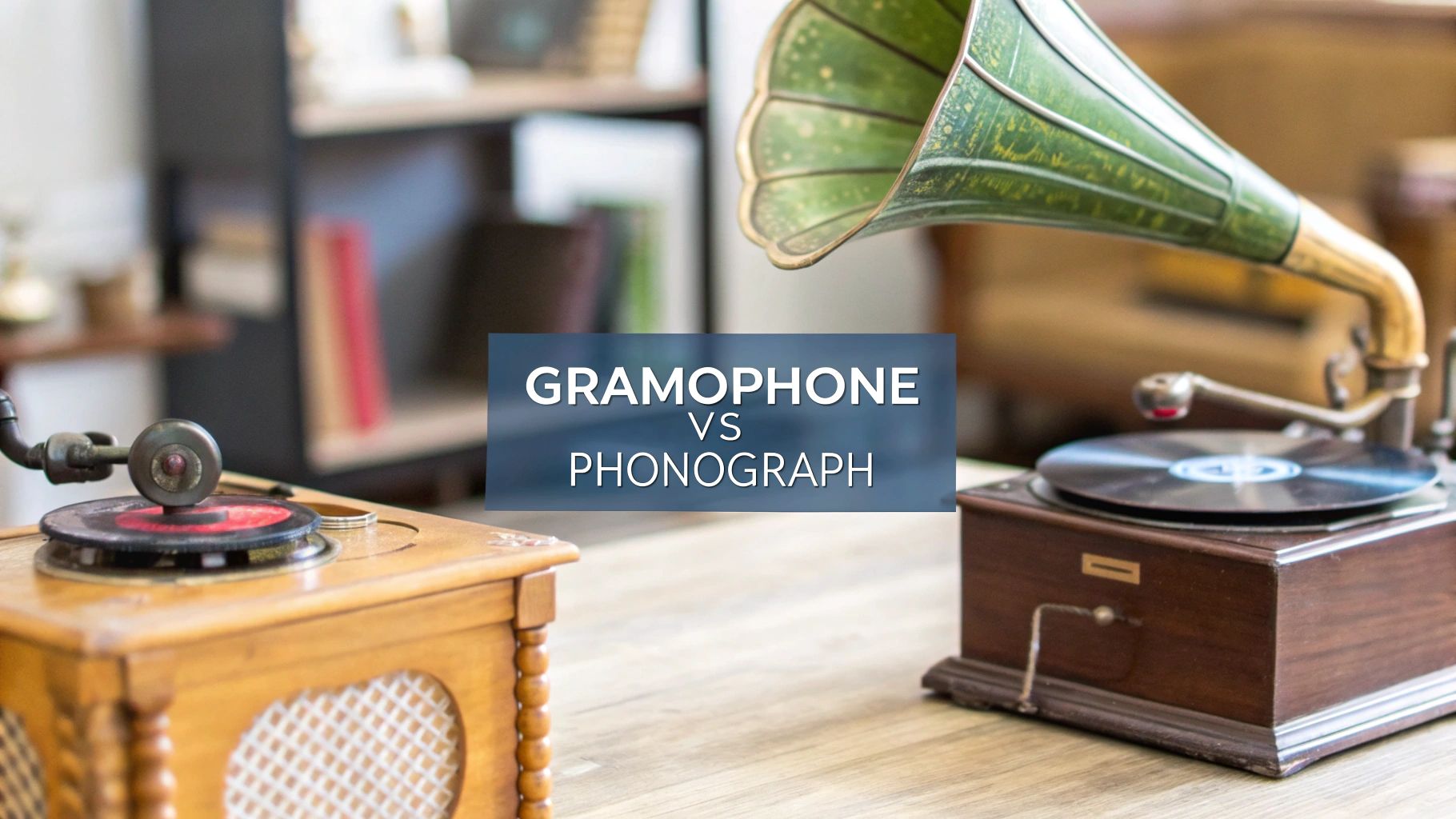When people talk about old-timey record players, the words "gramophone" and "phonograph" often get used interchangeably. While they're both ancestors of the modern turntable, they were actually fierce competitors born from two completely different ideas about how to capture and share sound.
The whole gramophone vs. phonograph story really boils down to one thing: cylinders versus flat discs. Thomas Edison’s phonograph used cylinders, and Emile Berliner’s gramophone used discs. That single choice affected everything that followed, from how the machines were built to which one ultimately won the market and shaped the future of music.
Understanding the Core Differences
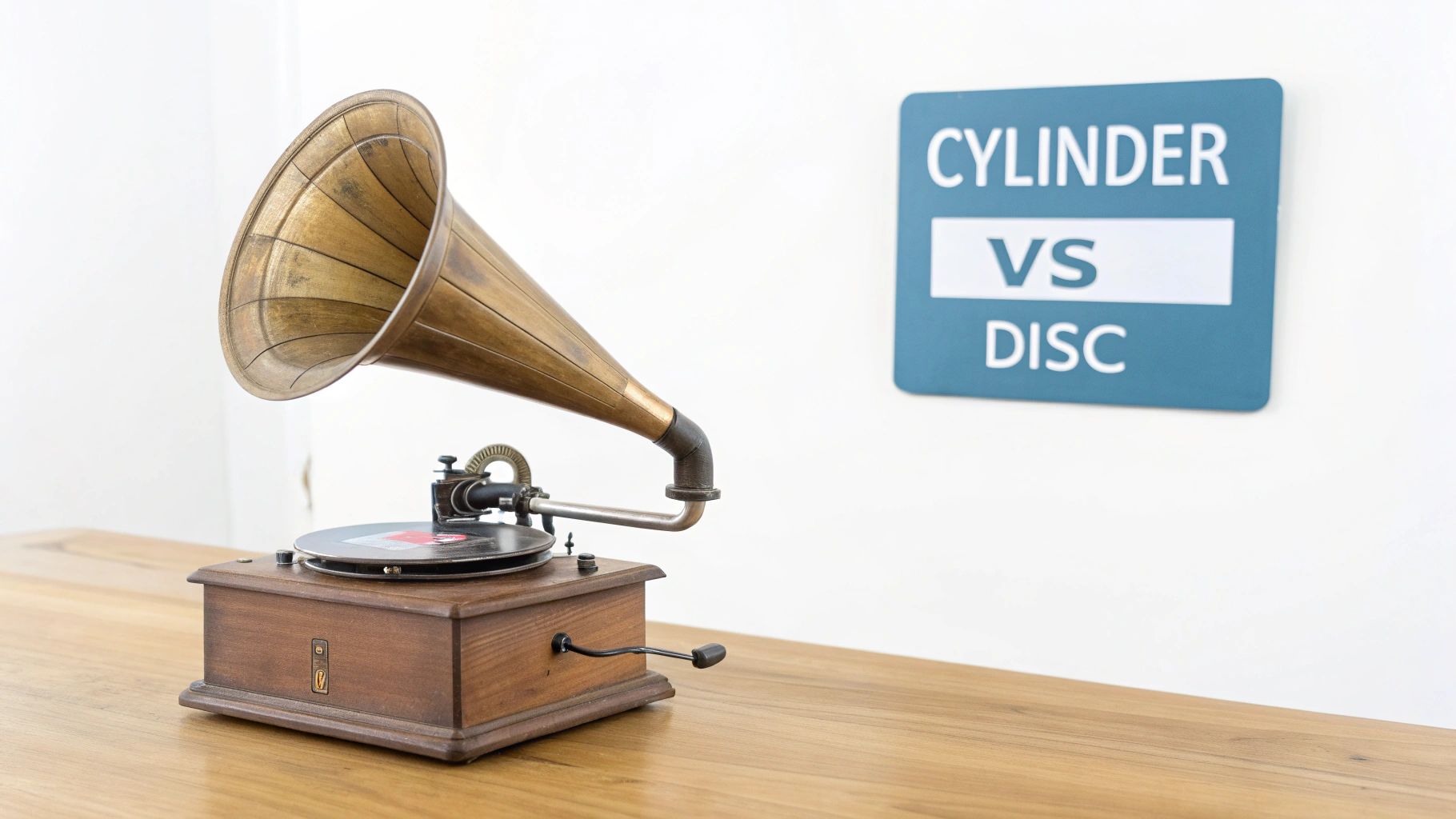
To really get a feel for this rivalry, you have to look at the inventors. Thomas Edison unveiled his phonograph in 1877, and it was an incredible piece of engineering. It could both record and play back sound using wax cylinders, and Edison saw it as a serious business tool for dictation or even as a way for families to preserve their loved ones' voices.
Ten years later, Emile Berliner came along with his gramophone, and he had a totally different vision: entertainment for everyone. Instead of cylinders, he used flat discs made from shellac. This wasn't just a random design tweak—it was a game-changer. Edison's cylinders were a pain to copy; each one had to be recorded individually. Berliner’s discs, on the other hand, could be stamped out from a master copy by the thousands.
This set up the ultimate showdown. Edison chased pristine sound quality with his vertical "hill-and-dale" grooves, which captured more detail. Berliner, however, focused on making music accessible and affordable with his side-to-side lateral grooves.
The core conflict wasn't just about technology, but about two competing business philosophies. Edison sold a high-fidelity, personal recording device, whereas Berliner sold a simple, affordable way to bring professionally recorded music into every home.
At a Glance: Phonograph vs. Gramophone
This table breaks down the essential distinctions between these two groundbreaking audio devices. It's a quick look at how their initial design choices sent them down completely different roads.
| Feature | Phonograph (Edison) | Gramophone (Berliner) |
|---|---|---|
| Inventor | Thomas Edison | Emile Berliner |
| Year Patented | 1877 | 1887 |
| Recording Medium | Cylinders (tinfoil, wax, plastic) | Flat Discs (shellac) |
| Groove Type | Vertical Cut ("Hill-and-Dale") | Lateral Cut ("Side-to-Side") |
| Playback Method | Stylus moves up and down | Needle moves side to side |
| Primary Advantage | Higher initial sound fidelity | Easy mass production and storage |
| Key Limitation | Difficult and slow to duplicate | More susceptible to wear and tear |
In the end, practicality won. The gramophone's disc was just a more commercially sound idea. They were easier to mass-produce, simpler to store, and eventually, the industry standardized them at 78 rpm. This created a huge, unified market that companies like the Victor Talking Machine Company capitalized on, building a global music empire and making the gramophone the true forerunner of the record player we know today.
The Format War: Cylinders vs. Discs
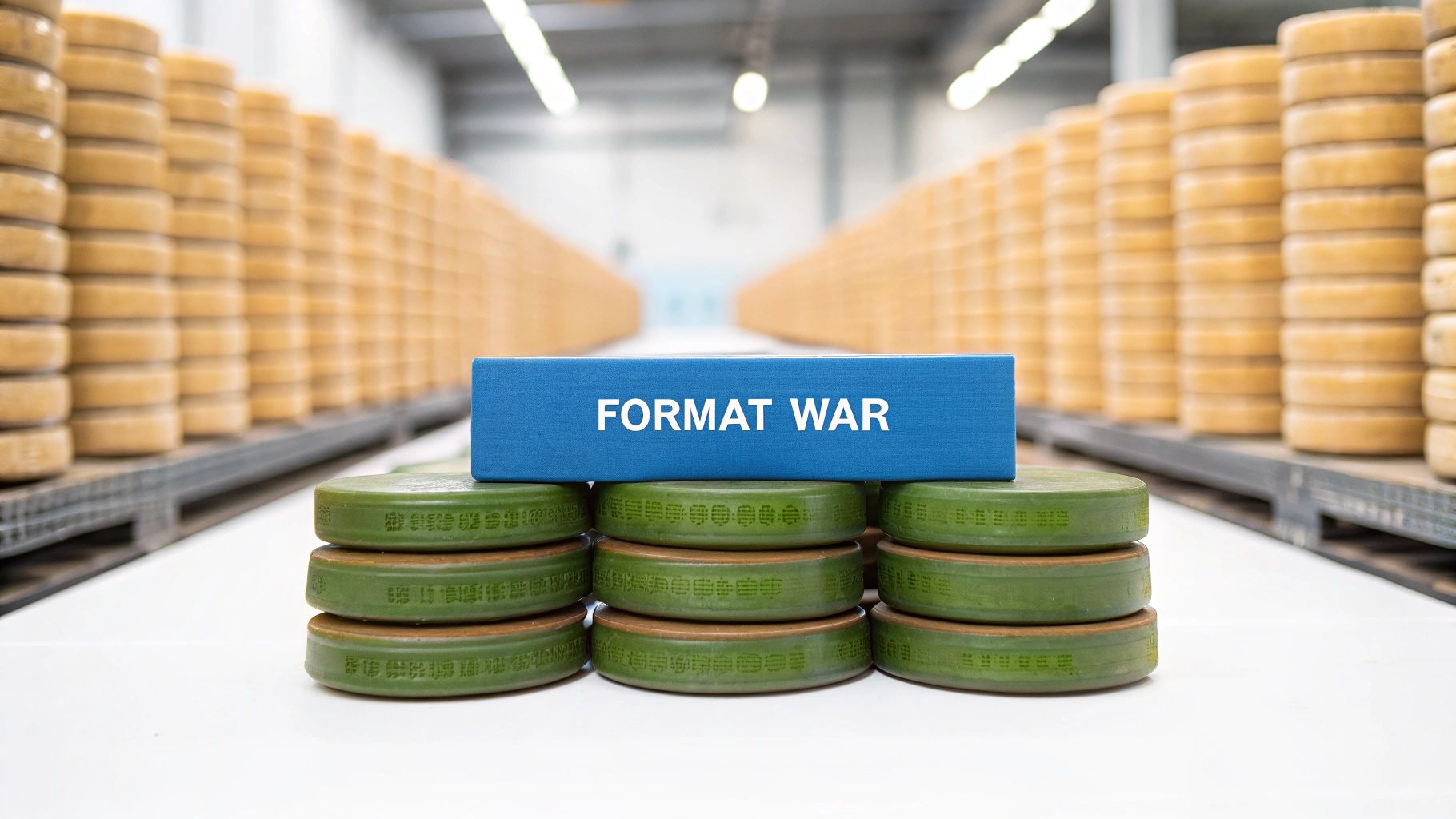
The rivalry between the gramophone and the phonograph wasn't really about which machine sounded better—it was a battle of strategy. At the heart of it all was a fundamental conflict between two competing formats: Thomas Edison's cylinders and Emile Berliner's flat discs. This format war would go on to shape the entire music industry for the next hundred years.
Edison's phonograph was the first on the scene, recording sound onto wax cylinders. For their time, these were technological marvels. But they had some serious practical problems that ultimately got in the way of them becoming a household staple.
A decade later, Emile Berliner came along with his gramophone, which played flat discs. It might seem like a simple design tweak, but this change had massive economic implications. It completely changed the game for how music could be produced, sold, and enjoyed by the public.
The Cylinder's Challenge: Playback and Production
Phonograph cylinders captured sound using a "hill-and-dale" method, where the stylus moved up and down within a groove cut vertically. This technique could actually produce pretty impressive sound for the era, but it came with some major baggage.
The biggest headache was duplication. In the early days, if you wanted copies of a cylinder recording, you had to record them one by one. Can you imagine an artist singing the same song over and over, hundreds of times, just to produce a few hundred copies? It was an incredibly slow and expensive way to do things.
Even when they figured out how to create molds for duplication, the process was still complicated and costly, especially when compared to what Berliner was doing with discs. This production problem was a critical weak spot for the cylinder.
On top of that, the cylinders themselves were bulky and fragile. Being made of wax, they could easily be damaged by a clumsy hand or a warm room. If you wanted to build a music collection, you needed a lot of space, which made them a tough sell for the average family home.
The Disc's Decisive Advantage
The gramophone disc, on the other hand, solved the production problem with incredible efficiency. Berliner's real genius wasn't just the flat disc itself; it was the manufacturing process he developed. A single master recording could be used to create a metal stamper, and that stamper could press thousands of identical copies—fast and cheap.
This was the birth of mass production in the music industry. It turned recorded music from a curious novelty into a product that could be sold on a massive scale.
This is the key difference that separated the two machines. Edison’s original 1877 phonograph recorded on those wax cylinders. Berliner's gramophone, which he patented in 1887, used flat, shellac discs. These discs were easier to mass-produce and eventually offered longer playback times. By the 1920s, Berliner’s disc system, standardized at 78 rpm, had completely taken over the music industry worldwide. If you're curious, you can learn more about the early days of the phonograph and its evolution.
Here’s a quick look at why discs won the war:
- Cost-Effective Production: Stamping out discs was infinitely cheaper and faster than making copies of cylinders. This let record companies sell music at a price regular people could actually afford.
- Superior Storage: You could slide flat discs into sleeves, which took up way less shelf space than clunky cylinders. A music lover could build a huge collection without needing an entire room for it.
- Enhanced Durability: While still brittle by today's standards, the early shellac discs were tougher than wax cylinders. They held up better to repeated use and handling.
- Double-Sided Playback: Eventually, discs offered music on both sides, essentially doubling the content for the same price. A cylinder could never do that.
The victory of the disc was a lesson in market economics. While Edison pursued acoustic perfection with his cylinders, Berliner focused on accessibility and scale. The ability to cheaply stamp out thousands of copies made music a commodity for the first time in history.
This economic edge was just too powerful to overcome. As the price of records fell and the selection of available music exploded, the public voted with their wallets and overwhelmingly chose the gramophone. The cylinder, for all its technical achievements, just couldn't compete on convenience and cost, sealing its fate as a fascinating but forgotten chapter in the story of recorded sound.
How Playback Mechanics Shaped the Sound
Beyond the format war of cylinders versus discs, the very guts of each machine—how the stylus actually read the groove—created two totally different listening experiences. The direction the stylus moved was everything. This one mechanical detail in the gramophone vs phonograph debate shaped sound quality, how quickly records wore out, and which machine ultimately won over the public.
Thomas Edison’s phonograph used what's called a vertical-cut or "hill-and-dale" system. The stylus bobbed up and down in the groove, tracing changes in depth to make sound. This approach was surprisingly good at capturing a wide range of audio information, often giving early phonographs a richer, more detailed sound.
Emile Berliner’s gramophone, on the other hand, used a lateral-cut method. Here, the needle wiggled from side to side. While this side-to-side motion was seen as less precise at first, its real genius was in its practicality. It was much less likely to skip and could handle minor scratches or imperfections on a record without a fuss.
The Stylus and Its Impact
The type of needle used was just as important. Edison, always chasing that perfect sound, used long-lasting sapphire or even diamond styli for his phonographs. These premium materials were gentle on the delicate wax cylinders and helped produce a cleaner, clearer playback.
The gramophone was built for the masses, so it used cheap, disposable steel needles. The problem? These needles were much harder than the shellac records they played. Each spin would literally grind away a little bit of the groove, meaning the sound quality got worse every time you played a record.
This left consumers with a pretty clear choice:
- Phonograph: You got better sound quality and your recordings lasted longer, but the cylinders were fragile and a pain to store.
- Gramophone: You got a tough, convenient format, but you paid for it with lower initial sound quality and records that wore out fast.
The mechanical philosophy was clear. Edison prioritized the perfect playback of a single recording, treating it like a delicate original. Berliner prioritized the distribution of thousands of cheap, durable copies, even if it meant sacrificing some fidelity and longevity.
Standardization of Speed: The Decisive Factor
Maybe the most important mechanical difference of all was playback speed. Edison’s cylinder phonographs didn't have one set speed; early machines could run anywhere from 100 to 160 rpm. This lack of a standard meant a cylinder recorded on one machine could sound comically fast or sluggishly slow on another.
Berliner’s gramophone brought order to the chaos. By 1912, his Gramophone Company helped establish 78 rpm as the industry standard. This was a game-changer. For the first time, you could buy a record anywhere in the world and know it would play correctly on your machine. By 1925, the disc format was dominant, and cylinder phonographs were already becoming relics. You can discover more insights on the history of phonograph records to see how this unfolded.
This was a brilliant business move. A standard speed created a universal system, fueling the growth of a global music industry. An artist in New York could record a song, have it pressed in London, and know it would sound right when played on a gramophone in Sydney.
In the end, the mechanical decisions behind the gramophone—its lateral-cut grooves, disposable needles, and standardized speed—were all aimed at creating a simple, dependable music experience for everyone. While Edison’s phonograph might have been the audiophile's choice in the early days, the gramophone’s sheer practicality won the war for the living room.
From Lab Equipment to Living Room Furniture
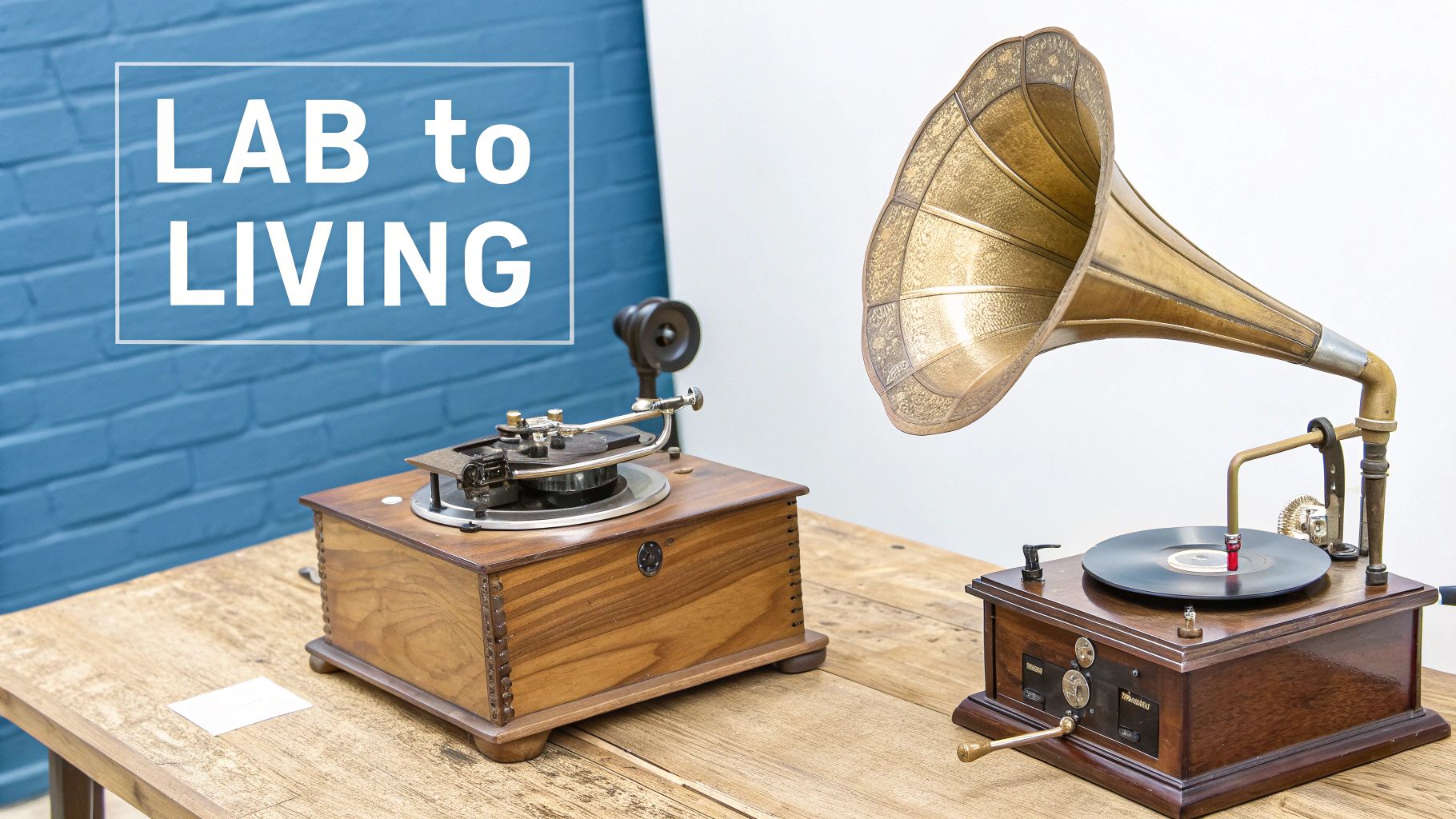
The gramophone vs phonograph debate goes much deeper than just mechanics. It’s really a story about how a machine went from a scientific curiosity to a prized piece of household furniture. Their designs tell you everything you need to know about where they were meant to live. Thomas Edison’s phonograph was born in a lab, and it absolutely looked the part—a raw, functional device built for a technical job.
Emile Berliner, on the other hand, saw his gramophone as the future centerpiece of home entertainment. This meant a totally different approach to design was needed. The goal wasn't just to play music; it was to create an object of beauty that a family would be proud to show off in their living room. This pivot from pure function to aesthetic appeal was a huge reason for the gramophone's runaway success.
The Phonograph: A Scientific Marvel
Early phonographs were wonders of engineering, but they certainly weren't designed with home decor in mind. They had exposed gears, stark metal horns, and simple wooden boxes that screamed utility over style. Edison originally imagined his invention as a serious tool for office dictation or preserving voices, and its no-nonsense look reflected that.
These machines often felt heavy and industrial, more at home in a workshop than a parlor. They definitely earned respect for their technical innovation, but they lacked the warmth and charm to really fit into a domestic setting. The entire focus was on the incredible, groundbreaking ability to record and play back sound.
The phonograph’s design was all about its purpose as a technical instrument. It was a machine to be operated and studied, not necessarily a piece of decor to be admired.
The Gramophone: An Object of Domestic Art
Berliner and companies like the Victor Talking Machine Company knew that to win over the home market, their product had to look like it belonged there. So, they started tucking the gramophone's mechanical guts inside beautifully crafted wooden cabinets, transforming it from a mere machine into a piece of elegant furniture.
These cabinets were often made from fine woods like oak, mahogany, and walnut, complete with intricate carvings and polished finishes that mirrored the popular furniture styles of the early 20th century. This brilliant move helped the gramophone become a symbol of status and culture. You weren't just buying a music player; you were buying a statement piece for your home. This design strategy was just as important to its success as the mass-producible disc format.
This change in design echoes other moments in history when technology became more accessible, like the evolution of the printing press from a purely industrial tool to something more widespread. You can see a similar journey in the history of the antique printing press and how its form evolved along with its function.
Even the iconic external horn got a makeover. What started as a simple amplifier became a design feature, often painted with floral patterns or shaped into elegant "flower" horns.
Eventually, the goal was to make the device even sleeker and more integrated:
- Internal Horns: The big, external horn was moved inside the cabinet, creating a much cleaner, self-contained look.
- Lid Integration: A hinged lid was added to cover the turntable and tonearm, making it look even more like a regular piece of furniture when not playing music.
- Record Storage: Designers started building shelves and slots right into the cabinets for storing records, turning the gramophone into an all-in-one entertainment hub.
This design evolution cemented the gramophone's role as the heart of home entertainment—a piece of functional art that brought families together. While the phonograph remained a fascinating piece of lab tech, the gramophone became a beloved member of the family.
How the Gramophone Built a Music Industry
Ultimately, the gramophone didn't win the format war because of better sound or fancier mechanics. It won because of shrewd business sense, smart mass production, and marketing that was nothing short of brilliant. While Thomas Edison was perfecting a high-end recording device, Emile Berliner and his partners were busy building an entire industry from the ground up.
Their approaches couldn't have been more different. Edison's phonograph, with its individually recorded cylinders, was more of an artisanal, expensive gadget. Berliner's gramophone, on the other hand, was built for the masses. The flat disc wasn't just a new shape; it was the key to a whole new way of thinking that turned music from a fleeting live performance into a product you could buy, own, and enjoy anytime.
The Power of Mass Production
The gramophone's single biggest edge was how it was made. In the early days, making copies of Edison's wax cylinders was a painfully slow and expensive process. Each one had to be recorded one by one, which naturally limited how many could be made and kept the price tag high.
Berliner’s system, however, was designed for duplication from the very beginning. An artist would record onto a master disc, which was used to create a metal "stamper." That stamper could then press out thousands of identical shellac records, fast and cheap. It was the assembly line applied to music, and it completely upended the phonograph's business model.
The real game-changer wasn't just the gramophone itself, but the entire system of mass production it unlocked. By slashing the cost of each copy, Berliner made recorded music something millions of people could actually afford, creating a market that barely existed before.
This efficiency had a huge impact on regular people. For the first time in history, an average family could start building a music collection. The difference in scale was incredible. While wax cylinders remained a tough-to-produce niche, shellac discs were being stamped out by the thousands every day. The numbers tell the story: between 1900 and 1920, millions of gramophone records flew off the shelves each year. By World War I, the public had made its choice, with discs outselling cylinders by a staggering ratio of roughly 95% to 5% in major markets. To get a better sense of how Edison’s technology worked, you can explore the history of his sound recordings.
Building a Global Brand
Great technology is one thing, but it takes marketing to build an industry. This is where companies like the Victor Talking Machine Company truly shined. They knew they weren't just selling a machine—they were selling the magic of having music in your home. Their masterstroke was creating one of the most iconic logos of all time: "His Master's Voice."
That image of Nipper the dog, listening intently to a gramophone horn, was pure marketing genius. It created an emotional bond, suggesting the sound was so real that even a dog could recognize its owner's voice. This branding turned the gramophone from a piece of hardware into a cherished part of the family.
Victor and others poured money and effort into growing the market through a few key strategies:
- Artist-Driven Content: They signed the biggest singers and musicians of the day, building a catalog of exclusive music people were desperate to hear. The focus shifted from the machine to the stars whose voices it carried.
- Mass Advertising: They ran ads in newspapers and magazines everywhere, making the gramophone a household name and something middle-class families aspired to own.
- Retail Distribution: They set up huge networks of dealers, so you could find their products in big city department stores and small-town music shops alike.
This blend of smart production and savvy marketing created a feedback loop. Lower prices led to more sales, which funded more recordings and advertising, which drove even more sales. Edison’s phonograph, with its higher price and limited supply, just couldn't compete. The gramophone didn't just win a format war—it built the foundation for the entire modern record industry.
Which Antique Machine Is Right for You
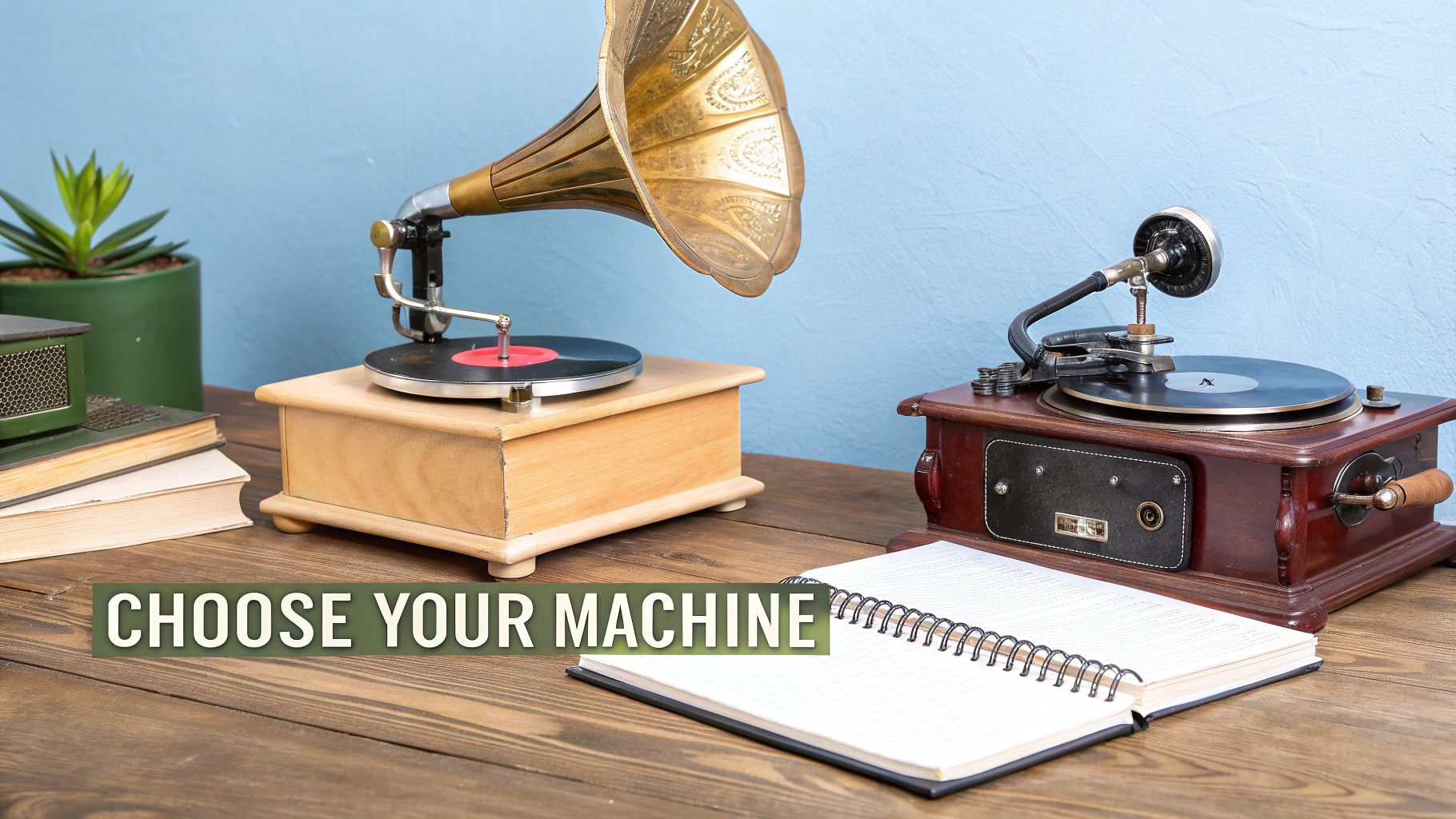
When you're deciding between a phonograph and a gramophone today, it's not really about which one is technically superior. It's about what you, as a collector, hope to get out of the experience. The real question isn't "gramophone vs phonograph," but rather which machine is the right fit for you. Your choice will likely come down to what you're passionate about—the history of technology or the joy of early recorded music.
If you’re a history buff captivated by the birth of sound recording, the phonograph is an incredible piece to own. It’s like having a slice of a science lab right in your home. This machine offers a direct line back to Thomas Edison's groundbreaking vision, with its distinct "hill-and-dale" recording method and wax cylinder format. It’s a device for tinkerers and historians who get a kick out of the clever engineering more than the musical performance itself.
On the other hand, if you actually want to listen to a wide range of early 20th-century music, the gramophone is hands-down the better option. The sheer number of 78 rpm discs still out there is massive compared to the limited supply of phonograph cylinders. This makes building a music collection for a gramophone much easier and more affordable, opening the door to a world of vintage jazz, blues, and classical recordings.
Key Buying Considerations
Before you pull out your wallet, take a moment to think about what you really want. Are you more fascinated by the machine as an object, or by the music it plays? Figuring this out is the first step toward a purchase you’ll be happy with and is essential to properly identify antiques that suit your collecting style.
Here are a few things to chew on:
- Music Availability: Gramophone discs are everywhere and usually pretty cheap. Phonograph cylinders are rare, much harder to track down, and can be quite pricey. It's a much more challenging format for collectors.
- Mechanical Complexity: Phonographs can be finicky machines, often demanding specialized skills to keep them running. Gramophones are generally simpler and more durable, with common replacement parts like steel needles still easy to find.
- Space and Storage: Flat gramophone discs are simple to store in albums. Phonograph cylinders, however, are bulky and incredibly fragile, needing a lot more space and careful handling to avoid cracks and breakage.
For the active listener, the gramophone offers a gateway to an expansive world of historical music. For the historical purist, the phonograph provides a tangible link to the very invention of recorded sound.
Ultimately, your choice in the gramophone vs phonograph debate really defines what kind of collector you are. The gramophone is for the music lover who wants to hear the past. The phonograph is for the historian who wants to hold it.
Frequently Asked Questions
Even after diving deep into the differences between gramophones and phonographs, a few questions tend to pop up. Let's tackle some of the most common ones that collectors and curious minds often ask.
Think of this as a quick chat to clear up any lingering confusion about these incredible old machines.
Can a Gramophone Play Modern Vinyl Records?
Definitely not. Trying to play a modern vinyl record on an antique gramophone is a surefire way to destroy it. Gramophones were built for one thing: playing thick, brittle shellac discs at 78 rpm. Their heavy steel needles would carve right through the soft vinyl grooves of a 33 or 45 rpm LP.
The pressure, or tracking force, of a gramophone’s tonearm is enormous compared to a modern turntable. That weight would gouge a modern record on the very first spin, ruining it forever. Always match the machine to the media.
Which One Sounds Better a Phonograph or a Gramophone?
That's a tougher question than you might think. In the early days, Edison's phonograph often had the edge. Its "hill-and-dale" vertical grooves and diamond stylus could capture a surprisingly rich and detailed sound for the era.
But Berliner's gramophone technology caught up fast. While a pristine phonograph recording might have sounded more faithful, gramophones produced a loud, clear, and punchy sound that people loved. It was simply more practical for a mass audience. Today, what you hear depends far more on the machine's condition and the recording itself than on which technology was "better."
The idea of "better" sound is really subjective here. The phonograph was aiming for high-fidelity reproduction, while the gramophone was all about loud, reliable entertainment. Both were wildly successful at what they set out to do.
How Can I Determine the Value of My Antique Player?
Figuring out what an old phonograph or gramophone is worth involves looking at a few key things. Rarity is a big one, as are the brand (Victor, Edison), model, and of course, its condition. Originality is king—a machine with all its original parts in good working order will always fetch a higher price than one that's been cobbled together or heavily restored.
For a true sense of its value, getting a professional opinion is your best bet. If you're just starting, our guide on how to appraise antiques gives you a great roadmap for what the experts look for. It's the perfect first step to understanding what your machine might be worth on the market.
Uncover the history and value of your own treasures. With Curio, you can snap a photo to instantly identify antiques, get detailed historical context, and receive an estimated appraisal right from your phone. Download Curio today at https://www.curio.app and let your antiques tell their story.
